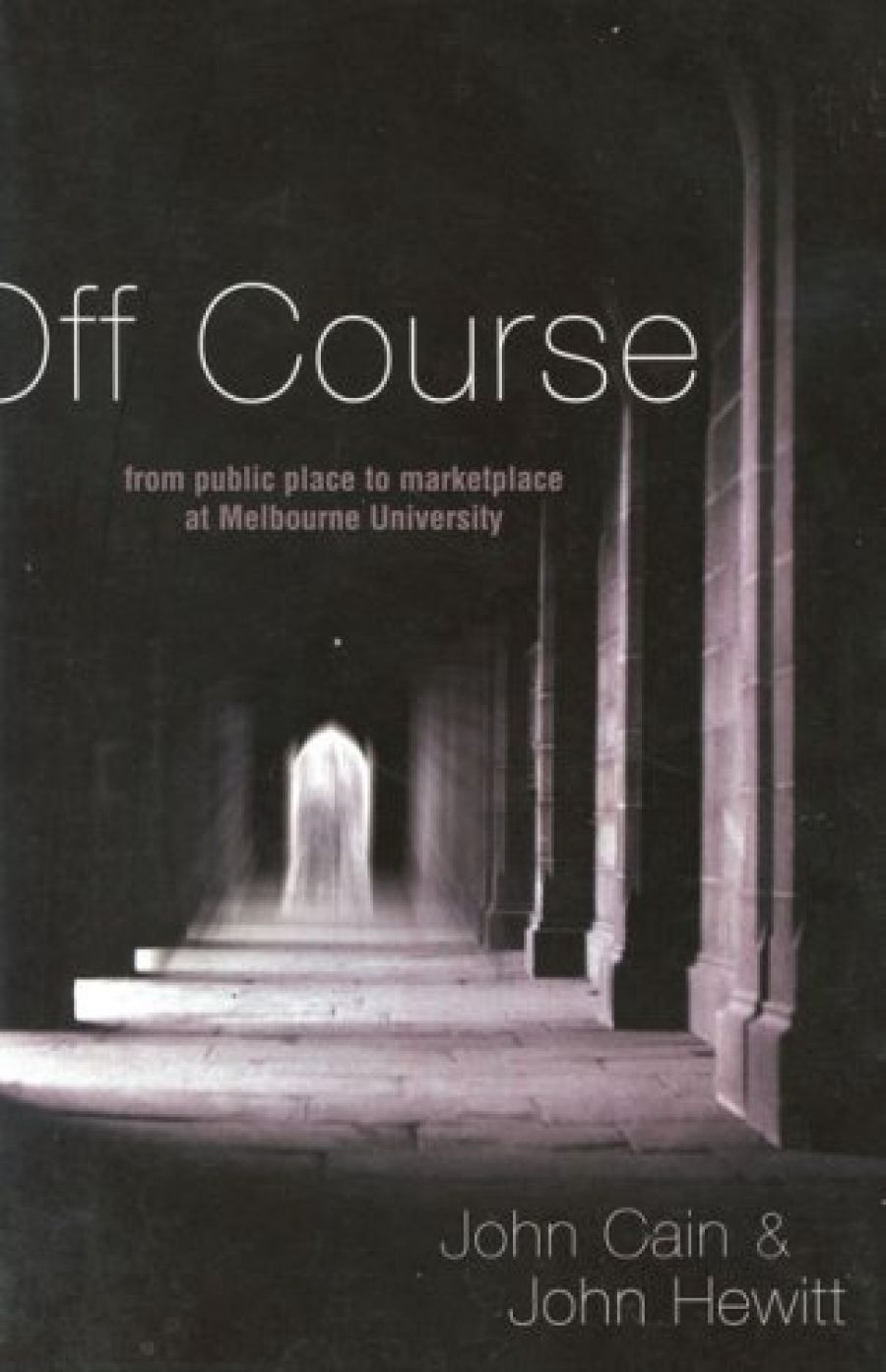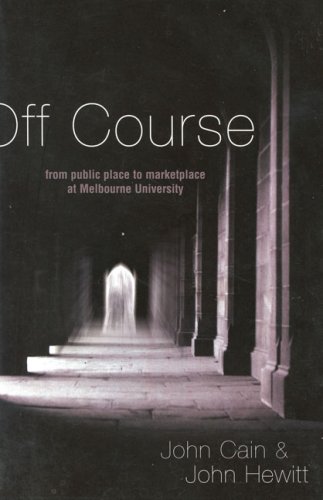
- Free Article: No
- Contents Category: Non-fiction
- Custom Article Title: A Cautionary Tale
- Review Article: Yes
- Article Title: A Cautionary Tale
- Online Only: No
- Custom Highlight Text:
Should the recent turbulent history of one university in one state of Australia matter to us? Some of the critics of Cain and Hewitt’s Off Course think not. Australian higher education has ‘moved on’, they claim. There is no question that the right ‘On Course’ for one-time public entities – from gas companies to universities – is to graduate from public ownership and statutory obligation to marketplace and deregulated freedom. Cain and Hewitt have simply missed the boat.
But have they? In the helter-skelter of change since the Dawkins ‘reforms’ of the late 1980s (which saw the abolition of the binary divide between universities and colleges, and a vast increase in the numbers of students undertaking tertiary education), there has been much movement at the top but not an equivalent acceleration of public enlightenment. There is a residual, stubborn, Robert Menzies-inspired public conception of what a university means and what nation-building role it should play in a democracy.
- Book 1 Title: Off Course
- Book 1 Subtitle: From public place to marketplace at Melbourne University
- Book 1 Biblio: Scribe, $30 pb, 234 pp
- Book 1 Cover Small (400 x 600):

- Book 1 Cover (800 x 1200):

But there are also ongoing – and politically exploitable – parental and student anxieties about the way tertiary education will fit (or not fit) graduates for work. There are contested professional and political understandings of the function of the university, plus complex negotiations over funding formulae and the ideologies implicit in them. It is not easy for the public, or for students (and their parents) now facing unprecedented financial commitments, to understand the rationales for change, or to comprehend what went before. And there is not much help available: Australian media don’t mediate well in this area. Higher education is covered mostly in supplements in the metropolitan dailies, designed to be read by the sector. If tertiary issues make news, it is usually because yet another education minister, often with an election in sight, is making his or her mark by announcing yet another reform, enquiry or new, vote-catching funding ‘package’.
So there are advantages to be had from not being on the boat, from standing in a fixed place and surveying the passing traffic. Perspective is one of them. Whether you agree or disagree with Cain and Hewitt’s conclusions, their systematic account of the postwar history of one tertiary institution, the University of Melbourne, is a useful measure of the well-being of the whole higher education system in Australia. It is also an instructive cautionary tale.
Both authors write with a degree of insider knowledge and outsider dispassion. John Cain has been a professorial associate at the University of Melbourne since 1991, in the department of political science. John Hewitt, now a school-teacher, is a former tutor in that same department. Cain’s own history – as Labor premier of Victoria from 1982 to 1990 – shows in his focus on process and probity, and in his stated conviction that Australia’s public universities exist to serve the interests of the nation. When the pair suggest remedies for the ills they diagnose at the University of Melbourne, they base those remedies on two premises: first, that Melbourne ‘always has been, and remains, a public institution, and as such is more than just another player competing in the education marketplace for staff, students and dollars’; and second, that ‘higher education and access to it are key components in a fair and equitable society’.
You might argue with the premises (I do not), but you do know, from the outset, where the authors stand. Their position is put plainly – no obfuscating rhetoric, no ideology masked as necessity. One might ask for more sparkle in the writing, but the lines of argument are clear: ‘The notion of a university as a public institution lies at the heart of this book.’
What does that mean? In answering, Cain and Hewitt have recourse to the 2001 Senate Committee report (Universities in Crisis, Report into the Capacity of Public Universities to Meet Australia’s Higher Education Needs): ‘This defines universities as institutions “with a historical basis in the public sector, established by state or Commonwealth statute, historically, and currently, in receipt of public funds, which form the single source of financial support for the institution”.’
The current position at the University of Melbourne (and all other Australian universities) demonstrates how far the still-public institution has shifted from its foundational rationale. Cain and Hewitt: ‘What we have seen at Melbourne seems to deny this definition. In terms of governance and control, a lack of policy guidance has left a void – one that has been filled by a series of vice-chancellors who have grown in authority as the management model has become more corporate in style, with power moving to the central administration.’ And as Melbourne has moved away from its definitional bases, so has federal funding ceased to be the ‘single source’. ‘Since the mid-1980s all governments,’ say Cain and Hewitt, ‘have progressively and quite savagely cut funding for higher education in real terms, while at the same time accepting that tertiary education is now for the masses.’
The authors describe as financially ‘catastrophic’ the decision by the Howard government in 1996 not to provide supplementation for academic salaries. As University of Melbourne deputy chancellor Norman Curry notes later in the book, it was the Labor Party that first decided not to provide supplementation. But wherever one lays the responsibility, the ‘catastrophic’ effects have been such as to force universities to scramble where and as they could to fund the consequent shortfall.
Cain and Hewitt analyse the history – from the Murray and Martin reports, through Whitlam’s free tuition phase and the Dawkins ‘revolution’, to the current financial straitening and shift in self-conception at the University of Melbourne. The one case stands, more or less, for the tertiary system as a whole. But when it comes to the University of Melbourne’s more entrepreneurial experiments with alternative funding sources in the 1990s, the focus shifts more closely, and more critically, to that institution alone. But the implication for other institutions is clear: beware! And heed our recommendations for alternative ways of facing the problems.
These Melbourne experiments – notably the controversial float of Melbourne IT, and the development (and, to date, sorry history) of Melbourne University Private (MUP) and the e-learning venture, Universitas 21 – generated considerable publicity at the time. The virtue of Cain and Hewitt’s account is that it puts them into handily linked context, and does so with the revealingly frank retrospective commentary of some of the key players. All three ventures raised serious questions about accountability, due process, the gap between promised and actual financial return, the entrepreneurial optimism of the University of Melbourne’s vice-chancellor, Professor Alan Gilbert, and the clout (or lack of it) of its governing body, the University Council. ‘It is with the University Council that much of the responsibility or what has happened must rest,’ the authors conclude. And it is about the Council that they make serious suggestions for reform of governance in their conclusions.
The ‘what has happened’ at Melbourne is the strong meat of the book, and at times its recounting makes one wince with astonishment. How could so much have been ventured with so few checks and balances? Inexperience? Naïveté? Enthusiasm uncoupled from a sense of public responsibility? Worse?
Pressing for profit and loss statements and a business plan (refused) from the then president and CEO of Melbourne University Private, Professor Barry Sheehan, the authors were told: ‘There’s a certain amount of smoke and mirrors, I’d have to confess.’ Interviewing Phil Honeywood, Victorian education minister at the relevant period, they heard that: ‘It would be fair to conclude that after all the promises made the end result of MUP has been a disappointment. With the benefit of hindsight, you cannot help but wonder whether the project, as delivered, was just a clever construct to by-pass planning obstacles or a genuine education initiative that went off the rails.’
You do indeed have to wonder. And then do more than that.


Comments powered by CComment